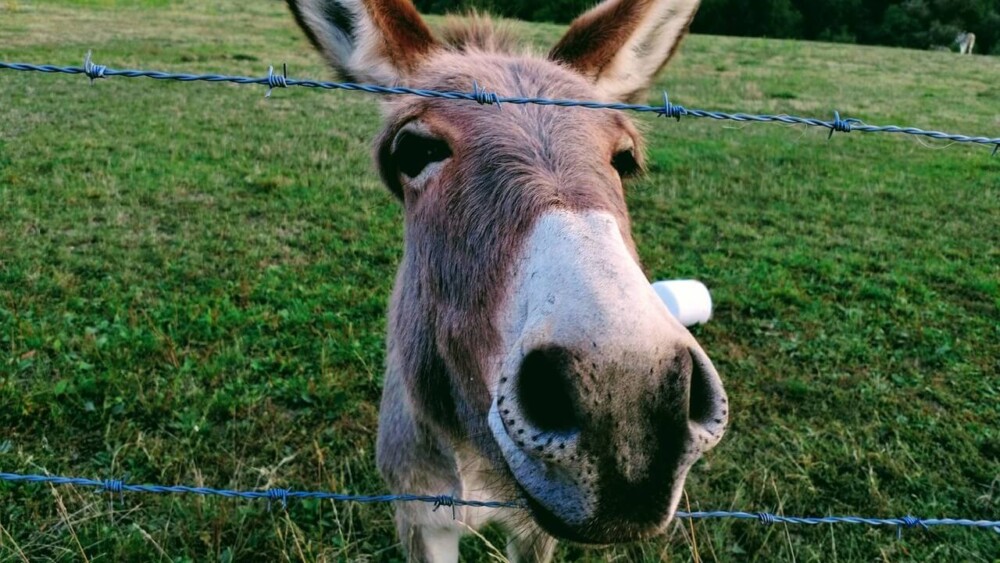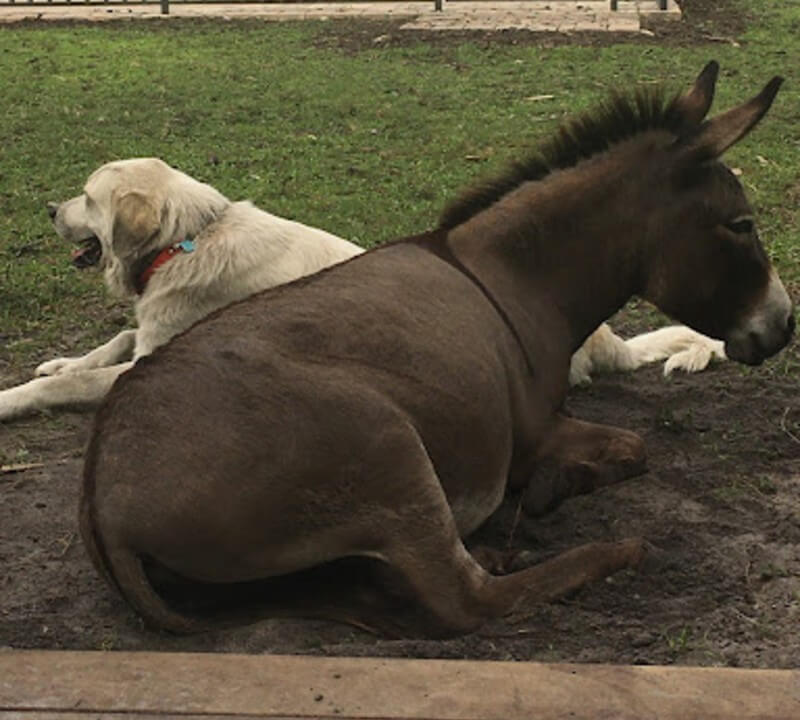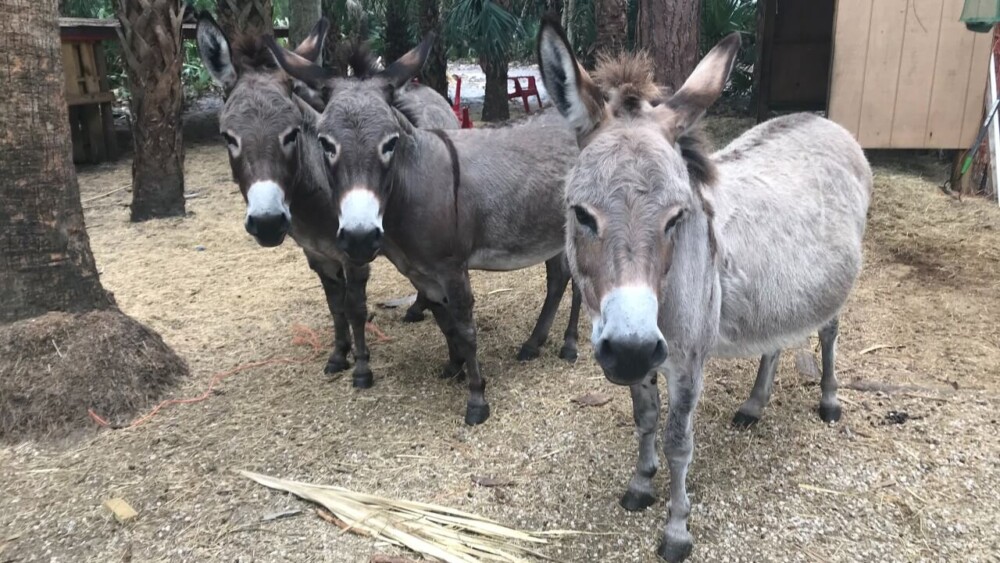Humans and donkeys have lived together and worked side by side for 6,000 years. In many depictions of them, donkeys are stubborn, thick-headed, and especially stoic. When I got my first donkey, I wondered; “Are donkeys as stoic as they appear, or are they able to express their emotions?”
Do donkeys show emotions? Donkeys appear to be stoic creatures, but with close observation, it becomes evident that donkeys, like horses and mules, demonstrate a full range of emotions and pain. Because their expressions are subtle, it is incumbent on their owners to spend time with them to monitor their well-being.
It can be difficult to understand donkey behavior. Fortunately, several studies have been able to isolate individual behaviors used almost universally by donkeys that identify their feelings. I’ll cover the basics below. You can also check out this article on how to bond with your donkeys.
Eight Indicators of Your Donkey’s Well Being
Once you understand what to look for in donkey body language, you’ll be able to read your donkey’s emotions and know how to best help it. Use this guide to check your donkey’s happiness levels!
Look at your donkey’s ear position.
The following positions suggest well-being:
- Ears that are both erect and to the side
- Ears that are both forward
- One ear forward and one to the side
The following positions indicate discomfort:
- Pointed-back ears
- Ears that are down
The following positions warrant your attention:
- Flat-back ears indicate irritation and possible aggression
- Ears that are pointing up and alert mean that your donkey is assessing the situation
Check your donkey’s head and neck position.
-
- The head at a level height suggests a content donkey.
- A consistently lowered head indicates depression or pain.
- A high head indicates concern or alertness.
Regard your donkey’s response to the environment.
-
- A content donkey is curious and engaged with the environment.
- A donkey in distress appears disinterested and bored.
Observe your donkey’s eyes.
-
- Bright, open but relaxed eyes indicate a healthy donkey.
- Dull eyes indicate a problem.
- Eyes that are so fully opened that the whites are exposed suggest distress.
Notice your donkey’s muzzle and nose.
-
- A relaxed nostril has a slight paisley shape.
- A tense nostril (that may indicate pain or anxiety) is almond-shaped or roundly open.
Watch your donkey’s tail.
-
- A swishing is a sign of a healthy donkey.
- A still tail demonstrates distress.
- A rapidly swishing tail signals high anxiety.
Note your donkey’s posture.
-
- A donkey turned towards the owner or assessor signifies a happy animal.
- A donkey that does not turn toward or engage with its owner is cause for concern.
- A relaxed back with a slight sway indicates good health.
- A slightly hunched back or abnormal stance suggests discomfort.
Listen to your donkey’s vocalization.
-
- A healthy bray is heard occasionally as an alarm to remind you it’s feed time.
- A silent donkey may be distressed.
- A raucous, persistent bray is a warning.
Because donkeys appear stoic, it is your responsibility to observe your herd carefully. Interact with your donkeys on a regular basis to get to know their temperament and to watch for signs of distress or concern. Below I’ll elaborate on each of the above categories so you can assess your own herd.
Many of these signs are subtle and could be confused with normal behavior. This is likely because donkeys evolved as prey animals. Showing signs of weakness could put them at greater risk of predation. Consistent indication of more than one of these indicators may be cause to call your vet, but brief moments of one or two are usually not cause for concern.

A Donkey’s Ears: Tell-Tale Signs of Emotion
A donkey’s ears are the greatest indication of its overall physical and mental state. If your donkey’s ears are both forward or both erect but to the side, you probably have a healthy donkey. Your donkey is interested in its surroundings and finds nothing of concern in its environment.
If its ears are consistently both back or both down, you’re going to want to observe it carefully for other signs of distress. Donkeys in pain are especially likely to have their ears down.
If your donkey’s ears are pinned flat to the back of its head, you’ll want to give it some time and space to calm down. Pinned-back ears are a sign of aggression.
One ear to the side and one flat back may indicate distress, though it could also mean that your donkey is focused on a sound on one side of its head. Some ear presentations may be either distress OR comfort; other indications (such as muzzle and nostril positions) are required to decide. (need images of this)
If your donkey is in a state of high anxiety, it may rapidly move its ears back and forth. This should be read as a “Leave me the heck alone” sign.
This donkey’s forward-pointing ears suggest she’s happy and alert.
A Donkey’s Neck and Head Position: Assessing Well-Being
A donkey’s neck isn’t often the type of body language owners look to assess their donkey’s overall well-being. But, studies have shown that the neck and head position gives great indicators of a donkey’s emotional health. When your donkey is on high alert, it will have a raised head. Depression is usually manifest with a llowered head. A level head indicates a calm demeanor.
A donkey on high alert is more likely to attack than retreat. Unlike horses, who spook readily and run, donkeys stand their ground, assess the situation, and then decide to take action.
The first time I brought a new animal to our farm, I proudly introduced him to our donkeys by plopping the lamb down in front of the donkeys. It took two minutes for the dominant female to raise her head, rear up, and try to trounce the little fella.
Fortunately, my husband, I, and our LGDs were there. The lamb was ok, but we learned quickly about how to better introduce new animals to donkeys that day.
Since then, we introduce new animals to our donkeys slowly. New animals are introduced through a fence for a couple of weeks. Then we watch carefully for our donkeys’ responses when we finally put them together. We make sure there are no displays of aggression from the donkeys. It is a harrowing sight to see donkey aggression; even miniature donkeys can do serious damage when they are provoked.
A Donkey’s Response to its Environment
The third strongest indicator of a donkey’s well-being is its response to its environment. A thriving donkey is curious and inclined to engage with its environment. This may mean sniffing an outstretched hand or showing interest in or moving toward people within its range.
A distressed donkey may show avoidance, aggression, or disinterest in handlers or owners.
Moving to a new environment will likely cause stress in your donkey. When you first acquire donkeys, you’re going to have to do some work to get to know them. If they avoid you, it’s because they don’t trust you yet and they’re anxious. You’ll have to spend time with them to build a relationship.
A Donkey’s Eyes
A donkey’s eyes also reflect its emotional and physical well-being. A rounded eye or an almond shape indicates a content or curious donkey. An eye with its white showing or a narrow wedge of an eye suggests a donkey is in discomfort. A glazed look in a donkey also warrants concern. Such a donkey may be depressed or in pain.
An easy way to remember the signs of pain or discomfort is to think of the eye as an orbit (the actual technical term). Orbital tightening is when the orbit (roundness) of the eye is squeezed shut to some degree. The tighter the orbit, the greater indication of pain.
Ironically, the opposite is true as well. The more open the orbit, the more likely the donkey is in pain as well. The more white showing in a distressed donkey’s eye, the more discomfort it is likely to experience.
A Donkey’s Muzzle and Nostrils
While it is not immediately evident, even a donkey’s muzzle and nostrils can indicate their comfort level. A donkey that is willing to sniff its environment and show curiosity is likely a content, healthy donkey. And a donkey who is not interested in sniffing its owner’s or handler’s hands may be in emotional distress.
A tense donkey will show it in the shape of its nostrils. Paisley-shaped, relaxed nostrils indicate well being, while semi-closed (almond shaped) or roundly open nostrils suggest tension and distress.
A donkey that is constantly snorting at you or flaring its nostrils is likely warning you of its desire to be left alone. It might be better to give it some space for a time.
At times your donkey may look as if it is smiling. It will curl its upper lip up and stretch its neck out. While not a smile in the human sense, this action is a sign of curiosity and interest in its environment. A donkey, like many mammals and all snakes and lizards, has an organ that helps it smell located in its nasal cavity.
This donkey smile is called a flehmen response. The curled lip allows more of the scent particles to enter its nasal cavity so it can smell its environment better than if it were to use its nose alone. Excessive flehmen responses may also be warning signs of discomfort.
The paisley-shaped nostrils, comfortably open eyes, and interest in their handler (and her snacks!) all demonstrate well-being in these donkeys.

A Donkey’s Tail
A donkey’s tail, like a dog’s tail or even a goat’s tail, tells about its mental and physical state. While a donkey’s tail is often used as a tool to keep flies or other pests at bay, regular swishing and tail twitches also indicate well-being in a donkey. A still tail suggests depression and malaise.
A still tail is a negative sign and a swishing tail is a good sign. But, a tail that rapidly swishes could be a sign of stress or anxiety as well. If you have a high fly or mosquito load, you’ll need to observe carefully to determine whether the rapidly swishing tail is anxiety or simply irritation at the pests.
A Donkey’s Posture
Donkeys give the silent treatment when they’re disengaged or in pain. A donkey with a healthy disposition and feeling well will face its owners or handlers when they approach. A donkey that faces away from the owners and handlers demonstrates apathy or discomfort.
The donkey’s posture demonstrates potential health problems if the donkey has an abnormal stance or even the slightest limp. If you see your donkey standing with a slightly hunched back, lowered head and partially closed eyes, you can know your donkey is uncomfortable.
Like horses, if a donkey strikes a pose with one of its back legs cocked, it’s smart to make yourself scarce. This is often accompanied by ears pinned back and an intent to kick the offending creature.
As someone who has been on the receiving end of a swift donkey kick to the thigh, I can attest that it is not a pleasant experience. Because my donkey kicked playfully I was not given the warning pose. But, playful or malicious, a donkey kick can do some damage.
If a donkey is in a great state of agitation, its entire body may tremble or shake. This is not a subtle indication of anxiety and should be respected by distancing yourself from the donkey. Pawing the ground repeatedly sometimes suggests discomfort as well. Jennys about to foal will often paw the ground and then lie down and roll from side to side.
A Donkey’s Vocalization
Healthy, well-adjusted donkeys like to talk. They evolved in areas with vast expanses of land that required long-distance communication, which explains why their brays are so ear-splittingly loud at times. Jacks are more likely to bray than jennys, but if a jenny finds a handsome jack and is in the mood, she will call out and let him know.
A bray is not the only sound a donkey makes. In addition, they snort, grunt, squeal, growl, and whuffle. Many of those sounds can be heard when jennys talk to their foals or play with other herd mates.
A distressed bray is distinct from the “You’re late for dinner” bray that you will hear anytime you’re five minutes off schedule. The distressed bray is loud and non-stop for quite some time. It may be due to a new animal on the farm or a predator nearby. It is worth your attention.
When we brought a visiting 5lb puppy on property once, our donkeys got a whiff of it and immediately let loose with a braying session that lasted a full 20 minutes without a breath. It was both humorous and awful. Our donkeys were sincerely concerned about their well-being, but the little puppy couldn’t have hurt a hair on their heads.
This nervous vocalization is one of the reasons donkeys can be used as livestock guardians. It is loud enough to frighten off most predators and to alert any owners within a mile or so.
A silent donkey is another warning of possible sickness or depression. This is especially true if your donkey typically is more vociferous.
Conclusion
Donkeys, like other animals, express happiness as well as pain and stress. On our farm, we call these playful moments their happy fits. Our small herd of three donkeys (a mom, her jenny, and her john) race around our property snorting, braying, and whuffling. They spin around corners, kick out in joy, and egg each other on. It is delightful to witness.
While there is not room in this article to discuss how to maintain happy donkeys, watch for another article about how to assure that your farm is using the best practices to keep a happy, healthy herd of donkeys. Your donkey will thank you.
References
Recognition of Donkey Pain, 2015 study
The 2020 study was used to create a Donkey Grimace Scale.
My Favorite Equine Resources For Horses and Donkeys
This list contains affiliate products. Affiliate products do not cost more but helps to support BestFarmAnimals and our goal to provide farm animal owners with accurate and helpful information.
Squeaky Chicken Toy is hilarious to watch and the horses love it! It’s not super tough so keep it away from dogs.
Dewormer with Ivermectin: I use this for my horses and my goats. Duvet makes a great dewormer. I switch between the Ivermectin one and one like this one so the worms don’t get immune to it.
Manna Pro Apple Flavored Nuggets are a delicious smelling treat that my horses go crazy over.
Equinity Amino Acid Supplement for Horses makes a big difference for any horse that’s struggling with arthritis, hoof issues, or just generally. It’s great for older horses who can’t absorb all the nutrients in their food as well!
Manna Pro Weight Accelerator helps older horses gain weight and stay healthier! This was especially helpful when one of my older horses lost weight over the winter and helped her regain her weight over the summer!
Farnam Fly Control goes on the horse or donkey and will keep the flies off your sweet pet. It makes horses way more comfortable and will keep sores from getting infected as well.
Wound Kote protects sores and wounds. It acts as an antiseptic and helps wounds heal faster. It works on both my horses and goats.




